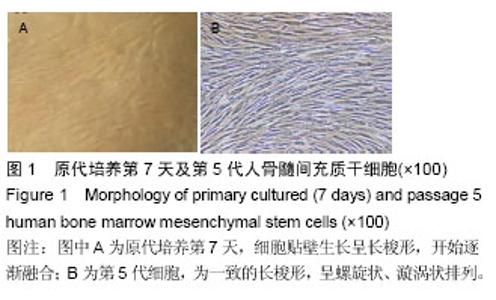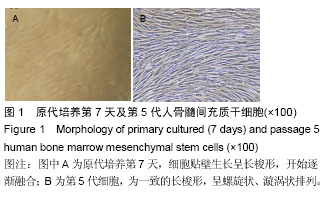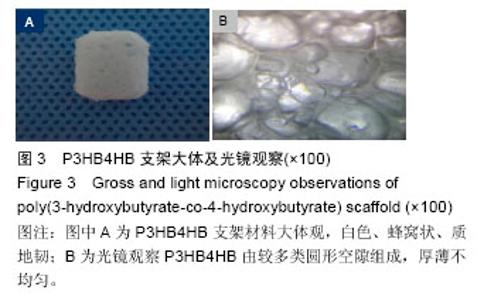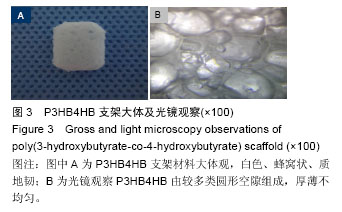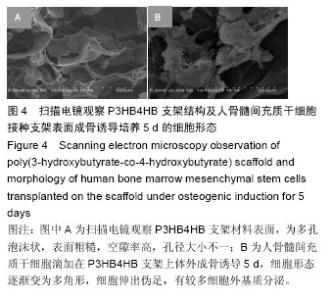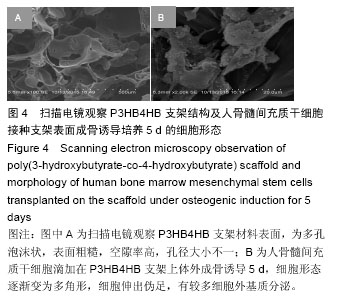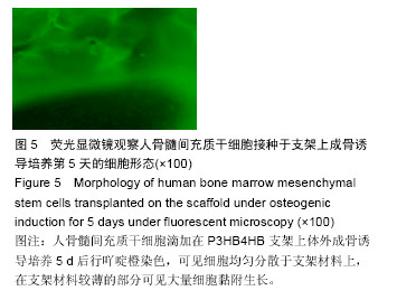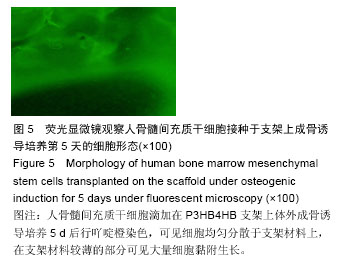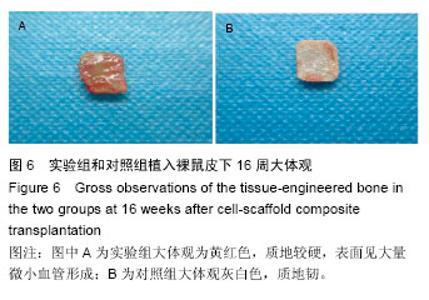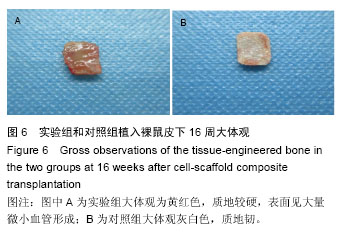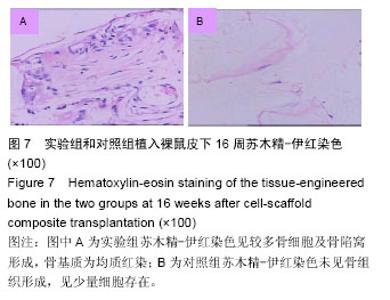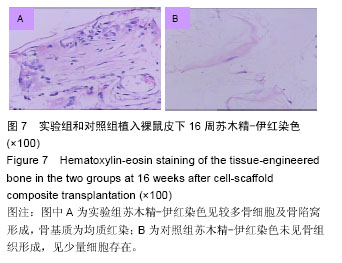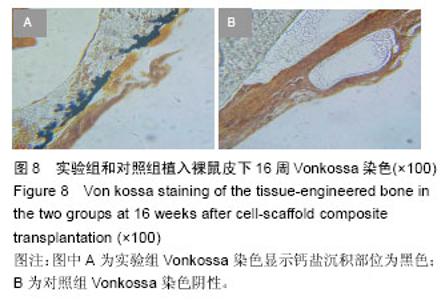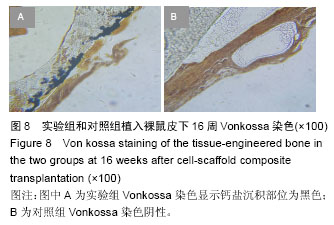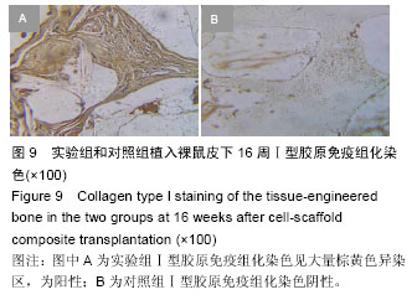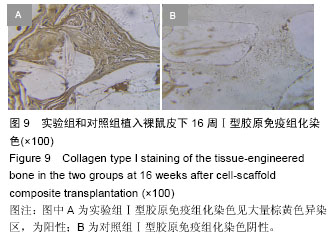Chinese Journal of Tissue Engineering Research ›› 2016, Vol. 20 ›› Issue (21): 3057-3064.doi: 10.3969/j.issn.2095-4344.2016.21.003
Previous Articles Next Articles
Poly(3-hydroxybutyrate-co-4-hydroxybutyrate) scaffolds carrying human bone marrow mesenchymal stem cells for bone tissue engineering
Zhang Jun-biao1, 2, 3, He Zhi-xu2, 4, Ye Chuan2, 5, Wang Yong3, 6, Wang Mei7, Liu Qin2, 3, Yang Long2, Li Jing2, Ma Min-xian3, 6
- 1Guizhou Medical University, Guiyang 550004, Guizhou Province, China; 2National and Guizhou Joint Engineering Laboratory for Cell Engineering and Biomedicine Technique, 3School of Stomatology, 4Department of Pediatrics, Guizhou Medical University, Guiyang 550004, Guizhou Province, China; 5Department of Orthopedics, 6Department of Stomatology, Affiliated Hospital of Guizhou Medical University, Guiyang 550004, Guizhou Province, China; 7Guiyang Stomatological Hospital, Guiyang 550004, Guizhou Province, China
-
Received:2016-03-09Online:2016-05-20Published:2016-05-20 -
Contact:Ma Min-xian, Associate chief physician, School of Stomatology, Guizhou Medical University, Guiyang 550004, Guizhou Province, China; Department of Stomatology, Affiliated Hospital of Guizhou Medical University, Guiyang 550004, Guizhou Province, China -
About author:Zhang Jun-biao, Studying for master’s degree, National and Guizhou Joint Engineering Laboratory for Cell Engineering and Biomedicine Technique, School of Stomatology, Guizhou Medical University, Guiyang 550004, Guizhou Province, China -
Supported by:the National Natural Science Foundation of China, No. 81360232; the Science and Technology Joint Foundation of Guizhou, No. 2012002; the Science and Technology Project of Guiyang, No. 20141001.
CLC Number:
Cite this article
Zhang Jun-biao, He Zhi-xu, Ye Chuan, Wang Yong, Wang Mei, Liu Qin, Yang Long, Li Jing, Ma Min-xian. Poly(3-hydroxybutyrate-co-4-hydroxybutyrate) scaffolds carrying human bone marrow mesenchymal stem cells for bone tissue engineering[J]. Chinese Journal of Tissue Engineering Research, 2016, 20(21): 3057-3064.
share this article
| [1] Black CR, Goriainov V, Gibbs D, et al. Bone Tissue Engineering. Curr Mol Biol Rep. 2015;1(3):132-140.[2] Jayasuriya AC, Shah C, Ebraheim NA, et al. Acceleration of biomimetic mineralization to apply in bone regeneration. Biomed Mater. 2008;3(1): 015003.[3] Lao L, Wang Y, Zhu Y, et al. Poly (lactide-co- glycolide)/hydroxyapatite nanofibrous scaffolds fabricated by electrospinning for bone tissue engineering.J Mater Sci Mater Med. 2011;22(8): 1873-1884.[4] Abousleiman RI, Sikavitsas VI. Bioreactors for tissues of the musculoskeletal system. Adv Exp Med Biol. 2006;585:243-259.[5] Schulz RM, Zscharnack M, Hanisch I,et al. Cartilage tissue engineering by collagen matrix associated bone marrow derived mesenchymal stem cells. Biomed Mater Eng. 2008;18(1 Suppl):S55-70.[6] Godara P,Nordon RE, McFarland CD, et al. Mesenchymal stem cells in tissue engineering. J Chem Technol Biotechnol. 2008; 83(4): 397-407.[7] Nazirkar G, Singh S, Dole V, et al. Effortless effort in bone regeneration: a review.J Int Oral Health. 2014; 6(3):120-124.[8] Wang J, Cui X, Zhou Y, et al. Core-shell PLGA/collagen nanofibers loaded with recombinant FN/CDHs as bone tissue engineering scaffolds. Connect Tissue Res. 2014;55(4):292-298.[9] Pilipchuk SP, Plonka AB, Monje A, et al. Tissue engineering for bone regeneration and osseointegration in the oral cavity. Dent Mater. 2015;31(4):317-338.[10] Amini AR, Laurencin CT, Nukavarapu SP. Bone tissue engineering: recent advances and challenges. Crit Rev Biomed Eng. 2012;40(5):363-408.[11] Hollister SJ. Porous scaffold design for tissue engineering. Nat Mater. 2005;4(7):518-524.[12] Lacroix D, Chateau A, Ginebra MP, et al. Micro-finite element models of bone tissue-engineering scaffolds. Biomaterials. 2006;27(30):5326-5334. [13] Liu Q, Cheng S, Li Z, et al. Characterization, biodegradability and blood compatibility of poly[(R)-3- hydroxybutyrate] based poly(ester-urethane)s. J Biomed Mater Res A. 2009;90(4):1162-1176.[14] Volova T, Goncharov D, Sukovatyi A, et al. Electrospinning of polyhydroxyalkanoate fibrous scaffolds: effects on electrospinning parameters on structure and properties. J Biomater Sci Polym Ed. 2014;25(4):370-393.[15] 马敏先,周祥文,王永,等.鼠骨髓间充质干细胞诱导的成骨细胞与3-羟基丁酸-3-羟基己酸共聚物的体外相容性[J]. 中国老年学杂志,2013,33(3):614-616.[16] Yang G, Cai ZJ. Preparation and Characterization of Electrospun Poly(3-Hydroxybutyrate-Co-4- Hydroxybutyrate)Nanofiber Menbranes. Advanced Materials Research. 2011;332-334:1527-1530.[17] Ou W, Qiu H, Chen Z, et al. Biodegradable block poly(ester-urethane)s based on poly(3- hydroxybutyrate-co-4-hydroxybutyrate) copolymers. Biomaterials. 2011;32(12):3178-3188.[18] 郭静,张欣,胡成女.聚(3-羟基丁酸酯-co-4-羟基丁酸酯)研究进展[J].合成纤维工业,2012,35(3):370-393.[19] Chen X, Yang X, Pan J, et al. Degradation behaviors of bioabsorbable P3/4HB monofilament suture in vitro and in vivo. J Biomed Mater Res B Appl Biomater. 2010;92(2):447-455.[20] Chanprateep S, Buasri K, Muangwong A, et al. Biosynthesis and biocompatibility of biodegradable poly(3-hydroxybutyrate-co-4-hydroxybutyrate). Polymer Degradation and Stability. 2010;95(10): 2003-2012. [21] 李楠,王雪明,齐宏,等.电纺丝聚乳酸、聚3羟基丁酸酯共聚4羟基丁酸酯和聚碳酸亚丙酯纳米纤维的制备及表面亲水性[J].中国组织工程研究与临床康复, 2010,14(12): 2273-2276. [22] 刘伟,刘萌,祝劲松,等.人骨髓间充质干细胞的体外培养、鉴定及成骨分化[J].中国组织工程研究, 2012,16(14): 2515-2519.[23] Gusi? N, Ivkovi? A, VaFaye J, et al. Nanobiotechnology and bone regeneration: a mini-review. Int Orthop. 2014; 38(9):1877-1884.[24] De Long WG Jr, Einhorn TA, Koval K, et al. Bone grafts and bone graft substitutes in orthopaedic trauma surgery. A critical analysis. J Bone Joint Surg Am. 2007; 89(3):649-658. [25] Kurien T, Pearson RG, Scammell BE. Bone graft substitutes currently available in orthopaedic practice: the evidence for their use. Bone Joint J. 2013;95-B(5): 583-597.[26] Inzana JA, Olvera D, Fuller SM, et al. 3D printing of composite calcium phosphate and collagen scaffolds for bone regeneration. Biomaterials. 2014;35(13): 4026-4034. [27] Luo Y, Lode A, Wu C, et al. Alginate/nanohydroxyapatite scaffolds with designed core/shell structures fabricated by 3D plotting and in situ mineralization for bone tissue engineering. ACS Appl Mater Interfaces. 2015;7(12):6541-6549.[28] Gusi? N, Ivkovi? A, VaFaye J, et al. Nanobiotechnology and bone regeneration: a mini-review. Int Orthop. 2014; 38(9):1877-1884. [29] Ye C, Hu P, Ma MX, et al. PHB/PHBHHx scaffolds and human adipose-derived stem cells for cartilage tissue engineering. Biomaterials. 200930(26):4401-4406.[30] 张弢,何志旭,叶川,等. 聚羟基丁酸/戊酸酯共聚物膜与的体外生物相容性[J].中国组织工程研究, 2014,18(12): 1920-1925.[31] Qiu H, Li D, Chen X, et al. Synthesis, characterizations, and biocompatibility of block poly(ester-urethane)s based on biodegradable poly(3-hydroxybutyrate-co- 4-hydroxybutyrate) (P3/4HB) and poly(ε-caprolactone). J Biomed Mater Res A. 2013;101(1):75-86.[32] Siew EL, Rajab NF, Osman AB, et al. In vitro biocompatibility evaluation of poly(3- hydroxybutyrate- co-4-hydroxybutyrate) copolymer in fibroblast cells. J Biomed Mater Res A. 2007;81(2):317-325.[33] Rao U, Kumar R,Balaji S,et al. A Novel Biocompatible Poly (3-hydroxy-co-4-hydroxybutyrate) Blend as a Potential Biomaterial for Tissue Engineering. Journal of Bioactive & Compatible Polymers. 2010;25(4):419-436. [34] Xu XY, Li XT, Peng SW, et al. The behaviour of neural stem cells on polyhydroxyalkanoate nanofiber scaffolds. Biomaterials. 2010;31(14):3967-3975. [35] Luo L, Wei X, Chen GQ. Physical properties and biocompatibility of poly(3-hydroxybutyrate-co- 3-hydroxyhexanoate) blended with poly(3- hydroxybutyrate-co-4-hydroxybutyrate). J Biomater Sci Polym Ed. 2009;20(11):1537-1553.[36] Wang X,Sang L,Wei Z, et al. Facile preparation and cytocompatibility of poly(lactic acid)/ poly (3-hydroxybutyrate-co-4-hydroxybutyrate) hybrid fibrous scaffolds. Polymer Engineering & Science. 2014; 54(12): 2902-2910.[37] Walmsley GG, McArdle A, Tevlin R, et al. Nanotechnology in bone tissue engineering. Nanomedicine. 2015;11(5):1253-1263.[38] Sikavitsas VI, Temenoff JS, Mikos AG. Biomaterials and bone mechanotransduction. Biomaterials. 2001; 22(19):2581-2593.[39] Burg KJ, Porter S, Kellam JF. Biomaterial developments for bone tissue engineering. Biomaterials. 2000;21(23):2347-2359.[40] Karageorgiou V, Kaplan D. Porosity of 3D biomaterial scaffolds and osteogenesis.Biomaterials. 2005;26(27): 5474-5491.[41] Wilson CE, de Bruijn JD, van Blitterswijk CA, et al. Design and fabrication of standardized hydroxyapatite scaffolds with a defined macro-architecture by rapid prototyping for bone-tissue-engineering research.J Biomed Mater Res A. 2004;68(1):123-132. |
| [1] | Pu Rui, Chen Ziyang, Yuan Lingyan. Characteristics and effects of exosomes from different cell sources in cardioprotection [J]. Chinese Journal of Tissue Engineering Research, 2021, 25(在线): 1-. |
| [2] | Lin Qingfan, Xie Yixin, Chen Wanqing, Ye Zhenzhong, Chen Youfang. Human placenta-derived mesenchymal stem cell conditioned medium can upregulate BeWo cell viability and zonula occludens expression under hypoxia [J]. Chinese Journal of Tissue Engineering Research, 2021, 25(在线): 4970-4975. |
| [3] | Zhang Tongtong, Wang Zhonghua, Wen Jie, Song Yuxin, Liu Lin. Application of three-dimensional printing model in surgical resection and reconstruction of cervical tumor [J]. Chinese Journal of Tissue Engineering Research, 2021, 25(9): 1335-1339. |
| [4] | Hou Jingying, Yu Menglei, Guo Tianzhu, Long Huibao, Wu Hao. Hypoxia preconditioning promotes bone marrow mesenchymal stem cells survival and vascularization through the activation of HIF-1α/MALAT1/VEGFA pathway [J]. Chinese Journal of Tissue Engineering Research, 2021, 25(7): 985-990. |
| [5] | Shi Yangyang, Qin Yingfei, Wu Fuling, He Xiao, Zhang Xuejing. Pretreatment of placental mesenchymal stem cells to prevent bronchiolitis in mice [J]. Chinese Journal of Tissue Engineering Research, 2021, 25(7): 991-995. |
| [6] | Liang Xueqi, Guo Lijiao, Chen Hejie, Wu Jie, Sun Yaqi, Xing Zhikun, Zou Hailiang, Chen Xueling, Wu Xiangwei. Alveolar echinococcosis protoscolices inhibits the differentiation of bone marrow mesenchymal stem cells into fibroblasts [J]. Chinese Journal of Tissue Engineering Research, 2021, 25(7): 996-1001. |
| [7] | Fan Quanbao, Luo Huina, Wang Bingyun, Chen Shengfeng, Cui Lianxu, Jiang Wenkang, Zhao Mingming, Wang Jingjing, Luo Dongzhang, Chen Zhisheng, Bai Yinshan, Liu Canying, Zhang Hui. Biological characteristics of canine adipose-derived mesenchymal stem cells cultured in hypoxia [J]. Chinese Journal of Tissue Engineering Research, 2021, 25(7): 1002-1007. |
| [8] | Geng Yao, Yin Zhiliang, Li Xingping, Xiao Dongqin, Hou Weiguang. Role of hsa-miRNA-223-3p in regulating osteogenic differentiation of human bone marrow mesenchymal stem cells [J]. Chinese Journal of Tissue Engineering Research, 2021, 25(7): 1008-1013. |
| [9] | Lun Zhigang, Jin Jing, Wang Tianyan, Li Aimin. Effect of peroxiredoxin 6 on proliferation and differentiation of bone marrow mesenchymal stem cells into neural lineage in vitro [J]. Chinese Journal of Tissue Engineering Research, 2021, 25(7): 1014-1018. |
| [10] | Zhu Xuefen, Huang Cheng, Ding Jian, Dai Yongping, Liu Yuanbing, Le Lixiang, Wang Liangliang, Yang Jiandong. Mechanism of bone marrow mesenchymal stem cells differentiation into functional neurons induced by glial cell line derived neurotrophic factor [J]. Chinese Journal of Tissue Engineering Research, 2021, 25(7): 1019-1025. |
| [11] | Duan Liyun, Cao Xiaocang. Human placenta mesenchymal stem cells-derived extracellular vesicles regulate collagen deposition in intestinal mucosa of mice with colitis [J]. Chinese Journal of Tissue Engineering Research, 2021, 25(7): 1026-1031. |
| [12] | Pei Lili, Sun Guicai, Wang Di. Salvianolic acid B inhibits oxidative damage of bone marrow mesenchymal stem cells and promotes differentiation into cardiomyocytes [J]. Chinese Journal of Tissue Engineering Research, 2021, 25(7): 1032-1036. |
| [13] | Wang Xianyao, Guan Yalin, Liu Zhongshan. Strategies for improving the therapeutic efficacy of mesenchymal stem cells in the treatment of nonhealing wounds [J]. Chinese Journal of Tissue Engineering Research, 2021, 25(7): 1081-1087. |
| [14] | Wang Shiqi, Zhang Jinsheng. Effects of Chinese medicine on proliferation, differentiation and aging of bone marrow mesenchymal stem cells regulating ischemia-hypoxia microenvironment [J]. Chinese Journal of Tissue Engineering Research, 2021, 25(7): 1129-1134. |
| [15] | Zeng Yanhua, Hao Yanlei. In vitro culture and purification of Schwann cells: a systematic review [J]. Chinese Journal of Tissue Engineering Research, 2021, 25(7): 1135-1141. |
| Viewed | ||||||
|
Full text |
|
|||||
|
Abstract |
|
|||||
